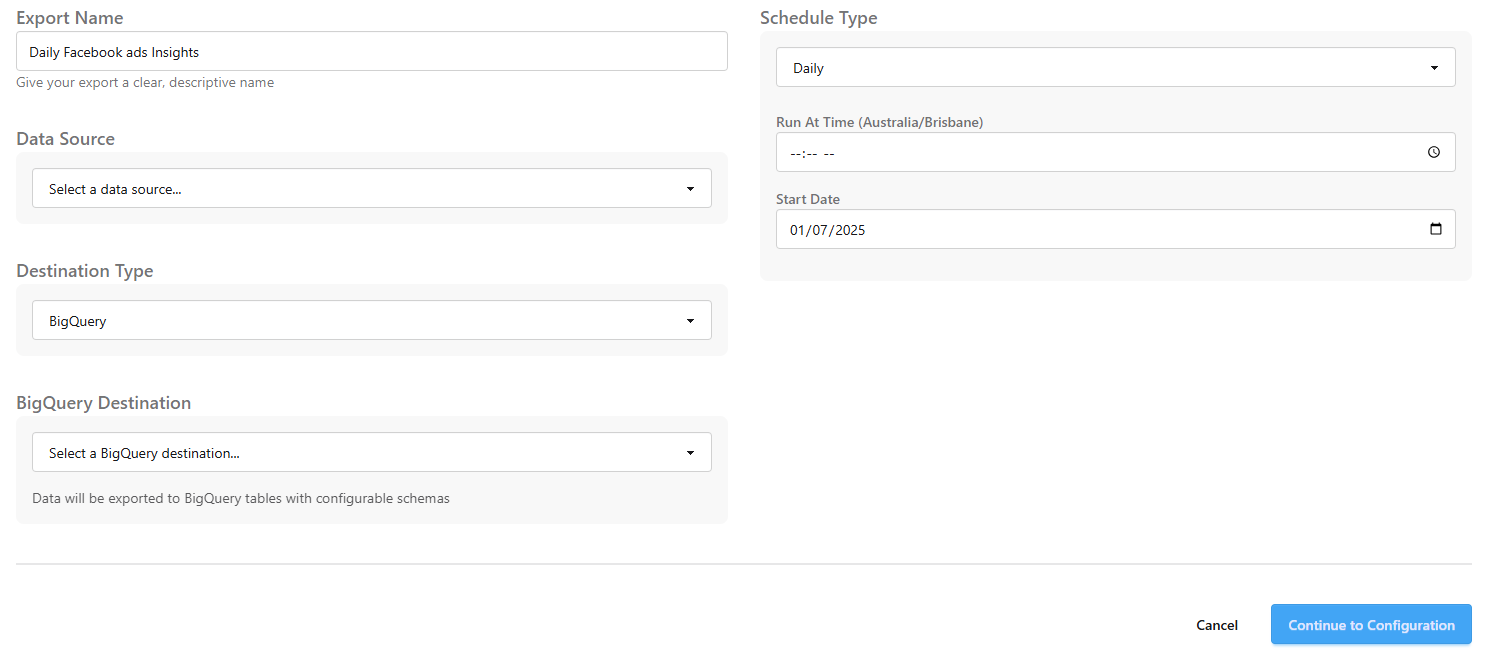How to Sync Facebook (Meta) ads into BigQuery
Google BigQuery is a fully managed data warehouse designed for large datasets and fast queries. This means it can easily handle millions of Facebook Ads records and let you analyse all your ads data.
BigQuery integrates with Google Cloud’s analytics tools, so it’s ideal for marketers who want powerful dashboards or machine learning on their ad data. SyncRange makes it simple to set up these connections without any coding.
First, connect your accounts in SyncRange. Go to Connections → Meta and click “Connect” to authorise SyncRange with Facebook/Meta. You must have a Meta Business account and admin access to your ad accounts. (SyncRange only needs read-only access to your ads.)
Then go to Google Integrations → BigQuery and click “Add BigQuery Destination”. Choose your Google Cloud project and select or create a new BigQuery dataset. Now your BigQuery dataset is connected and ready to receive data.
Setup Steps:
- Connect your Facebook/Meta Ads account to SyncRange.
- Connect Google and add a BigQuery dataset.
- In SyncRange's Export Builder, click “New Export” and choose Meta as the source.
- Select your connected BigQuery dataset as the destination and set a refresh schedule (e.g. daily).
Next, create the export and configure it. Give the export a name (for example, “Facebook Ads to BigQuery”) and pick the Meta Ad account. In the Export Builder, select which Facebook data you want to export: campaigns, ad sets, individual ads, performance insights, audiences, etc.
Pick the fields to include (such as Campaign Name, Impressions, Spend, Clicks, Conversions).
Choose the date range and whether to append or replace existing data. Generally, if you are syncing to BigQuery, you'll want to append data so you build up a database. Save the export, and SyncRange will run it automatically.

SyncRange will now run the export on the schedule you set. Each run loads your Facebook Ads metrics into the BigQuery tables you chose.
Because BigQuery tables can be date-partitioned, you can build a historical dataset that’s easy to query. Once the data is in BigQuery, you can query it directly or connect reporting tools (like Looker Studio) to analyse it.
For example, you could join Facebook Ad spend with your sales data to calculate ROI, or build dashboards of daily impressions and cost.
Benefits: Automating this sync saves you hours of manual work. No more CSV downloads or copy-pasting, SyncRange handles the API calls and keeps BigQuery updated. BigQuery’s performance lets you analyse huge ad datasets quickly. You can track key metrics like spend, CTR, conversions, and ROAS without lifting a finger. And since SyncRange is a no-code tool, marketers can set this up in minutes without a developer.
BigQuery vs Google Sheets: SyncRange supports both destinations. Use BigQuery when you have large or complex datasets (thousands to millions of rows) and need advanced analytics. Use Google Sheets when your data is smaller and you prefer a simple spreadsheet for quick charts and sharing. For large-scale Facebook Ads reporting, BigQuery is the recommended choice.
